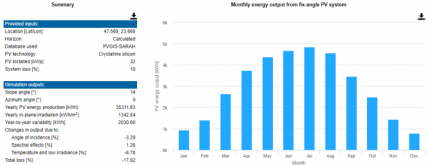Hi there all,
I'm near to finish my new house project, and because I'm newbie on the PV world, I need some advice please.
Here is what I want realize on the roof of my future house:
I
This because I will need a lot of current for my home consume, greenhouse, water pump, EV car... etc
So practically I want to make a 30-35 kW photovoltaic field on my roof,
and a LiFePo4 battery backup of about 40 kW (16S3P of 280Ah).
The PV panels will have aprox. Vmp= 33.3V / Imp= 9.6A / Voc=40V.
The roof will be South oriented, but only at 14° inclination (best in my zone is 30° aprox).
Here is the result of the production of the PV system:

All connected to the grid and also (if possible) have a quick switch from grid to batt. backup
in case of blackout of the grid power.
I also so a lot of Will Prowse video (thanks a lot Will), but I still not understand
witch is the difference between "MPPT + Inverter" and "Inverter that already include MPPT".
So can please help me with some advice please of witch can be the less cost Inverter for my case,
how many I must buy and how I must calculate the PV strings.
Or maybe if is too complicate, please tell me what I must to search in order to learn more,
and find by myself the near best combination.
Thanks all in advance.
Denis
I'm near to finish my new house project, and because I'm newbie on the PV world, I need some advice please.
Here is what I want realize on the roof of my future house:
I

This because I will need a lot of current for my home consume, greenhouse, water pump, EV car... etc
So practically I want to make a 30-35 kW photovoltaic field on my roof,
and a LiFePo4 battery backup of about 40 kW (16S3P of 280Ah).
The PV panels will have aprox. Vmp= 33.3V / Imp= 9.6A / Voc=40V.
The roof will be South oriented, but only at 14° inclination (best in my zone is 30° aprox).
Here is the result of the production of the PV system:

All connected to the grid and also (if possible) have a quick switch from grid to batt. backup
in case of blackout of the grid power.
I also so a lot of Will Prowse video (thanks a lot Will), but I still not understand
witch is the difference between "MPPT + Inverter" and "Inverter that already include MPPT".
So can please help me with some advice please of witch can be the less cost Inverter for my case,
how many I must buy and how I must calculate the PV strings.
Or maybe if is too complicate, please tell me what I must to search in order to learn more,
and find by myself the near best combination.
Thanks all in advance.
Denis


